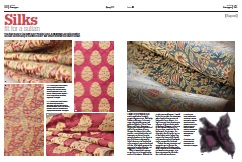
The silks made by the new luxury Turkish brand,Armaggan, are quite possibly the best fabrics being in the world today. Ben Evans unravels the historic thread
A NEW LUXURY BRAND HAS quietly appeared on Istanbul’s premier shopping street, Abdi Ipekçi Caddesi in Nişantaşı. In its seven storey shop nestled among such
celebrated labels as Chanel, Louis Vuitton and Cartier, Armaggan Nişantaşı has discreetly established itself in the pantheon of luxury.
However the objects that it offers, jewellery, natural dyed textiles and homeware are distinct from the material elsewhere in this district in that all of them are designed by Turkish designers and handcrafted in the company’s own ateliers based in Turkey, all of which represent the expertise of a cadre of leading, yet anonymous, Turkish craftsmen.
What is immediately apparent on my first visit is the outstanding quality of the objects. Although this is what one would expect, I would be the first to admit that sometimes when faced with expensive and high quality luxury objects, it is hard to escape from the pervasive influence of the marketing might of the brand. However, in the case of the Armaggan Nişantaşı it is clear on close inspection that the leatherwork, the ceramics, the silver-inlay, the silk textiles etc are of the highest order. Indeed they transmit the human skill, the deft craftsmanship and vital handmade quality espoused by the brand.
Perhaps the most interesting and appropriate way to illustrate the underlying ethos of the firm, and its intent, reflected in its affiliated design and manufacturing partners, is to
focus attention on the silk textiles that it sells and manufactures.
Silk brocades enriched with precious metal are the pinnacle of its achievement and represent years of research into the weaving methods, materials and dyes used to make the original fabrics in the Ottoman Imperial workshops in the 16th century 1-5. These valued silks conveyed the power of the state and court, were used as a mark of Imperial patronage, and, amongst other uses, were tailored in the Imperial family’s ceremonial caftans.
These antique fabrics are among the most precious, costly, most desired and coveted silks ever made. The route to reproduction starts at its partner, The Natural Dyes Research, Development and Application Center (DATU) sponsored by Armaggan Nişantaşı, where silks in museums such as the Topkapı Palace and the Textile Museum in Washington DC, were analysed in the state of the art laboratory to quantify their use of colour, dyestuffs,
gold and silk weaving. From this data, the methods of manufacture were replicated using natural organic dyes, as well as the same silk and gold content.
The fabrics are made on Jacquard looms restored and acquired by DATU – all Armaggan Nişantaşı fabrics are made on the centre’s other hand looms rescued from Anatolia so as
to preserve this craft. Thus the final small lengths of finished woven silk represent the work of many hands, much effort and a great deal of time.
The processes are as complex as the weaving technique yet the sublime beauty of the finished product do not revel in this complexity but are as free and exuberant as the patterns are themselves. For a local visitor to the store, one can enjoy seeing updated or revitalised versions of recognisable Turkish crafts and artefacts, yet for an overseas buyer, most Armaggan Nişantaşı products do not have an overtly recognisable Turkic aesthetic and, by virtue of their design and the quality of their production, are desirable contemporary design objet d’art or home furnishings. In other words they are very well-judged and
well-made, and indeed the intent behind of the brand is secondary to the beauty of the objects. www.armaggan.com